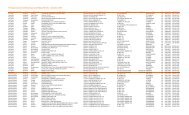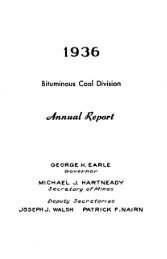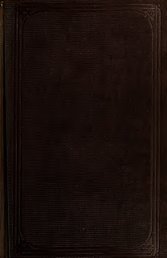Reports of the Inspectors of Mines of the anthracite coal regions of ...
Reports of the Inspectors of Mines of the anthracite coal regions of ...
Reports of the Inspectors of Mines of the anthracite coal regions of ...
Create successful ePaper yourself
Turn your PDF publications into a flip-book with our unique Google optimized e-Paper software.
138 <strong>Reports</strong> <strong>of</strong> <strong>Inspectors</strong> op <strong>Mines</strong>. [Xo. 10,<br />
owned or controlled b}^ <strong>the</strong> L. V. Coal Company. The fire, where it was<br />
first set, seems to have burned itself out, and tliat section is nearly cold.<br />
These old workings were never surveyed, and <strong>the</strong>re is no map or plan <strong>of</strong><br />
<strong>the</strong>m in existence. Tiie accompanying map will show <strong>the</strong> location <strong>of</strong> <strong>the</strong><br />
fire and its jjroximityto <strong>the</strong> adjoining properties. The plan explains itself<br />
and needs no explanation in addition to what appears on its face.<br />
The danger <strong>of</strong> damage from <strong>the</strong> fire arises from its spreading through<br />
<strong>the</strong> old workings into <strong>the</strong> workings <strong>of</strong> <strong>the</strong> Pennsylvania Coal Company,<br />
and consequently under <strong>the</strong> town <strong>of</strong> Pittston.<br />
The Tables Kxplnined.<br />
Tables Nos. 1 and 2 contain a list <strong>of</strong> all <strong>the</strong> accidents that occurred<br />
during 1877, and <strong>the</strong>ir causes; and each colliery is charged with <strong>the</strong> ac-<br />
cidents which occurred at each, respectively ;<br />
and it is hoped that all parties<br />
in charge <strong>of</strong> those collieries will examine <strong>the</strong>se tables carefully, and in-<br />
quire into <strong>the</strong> reason why so many more accidents occur in <strong>the</strong>ir mines than<br />
in o<strong>the</strong>rs.<br />
Tables Nos. 3 and 4 require no explanation.<br />
Table No. 5 contains some interesting statistics in relation to <strong>the</strong> amount<br />
<strong>of</strong> vvork done dui'ing <strong>the</strong> year. The figures relative to <strong>the</strong> amount <strong>of</strong><br />
powder used by <strong>the</strong> three large companies are estimates, because <strong>the</strong> agents<br />
<strong>of</strong> those companies saw proper to deny me <strong>the</strong> exact figures. The es-<br />
timates, however, are very nearly correct, and may be relied on, I have<br />
given <strong>the</strong> number <strong>of</strong> tons <strong>of</strong> <strong>coal</strong> mined at each colliery ; but it is proper,<br />
perhaps, to explain that <strong>the</strong> tons <strong>of</strong> <strong>the</strong> Delaware and Hudson Canal Company<br />
and <strong>the</strong> Pennsylvania Coal Company, with several, if not all <strong>the</strong><br />
smaller operators, whose <strong>coal</strong> is marketed by said companies, consist <strong>of</strong><br />
twenty-seven hundred weight. Or, in o<strong>the</strong>r words, <strong>the</strong>se companies re-<br />
quire <strong>the</strong>ir miners to insure <strong>the</strong>m a full ton <strong>of</strong> <strong>coal</strong> at tide water, after all<br />
<strong>the</strong> leakages and waste <strong>of</strong> transportation. But <strong>the</strong> ton <strong>of</strong> <strong>the</strong> Delaware,<br />
Lackawanna and Western Railroad Company, is a ton <strong>of</strong> two thousand<br />
two hundred and forty pounds at <strong>the</strong> mines, and all <strong>the</strong> smaller operators,<br />
who deliver <strong>the</strong>ir <strong>coal</strong> to this company, rate <strong>the</strong>ir tonnage in <strong>the</strong> same<br />
manner.<br />
By referring to this table, parties in charge <strong>of</strong> each colliery can ascer-<br />
tain <strong>the</strong> ratio <strong>of</strong> <strong>coal</strong> produced by <strong>the</strong>m for each life lost, and for each per-<br />
son injured during <strong>the</strong> year 1877, and during <strong>the</strong> last four years. The ratio<br />
ranges from 11,933.5 tons, at No. 6 slope, Pennsylvania Coal Company',<br />
to 159,268 tons, at <strong>the</strong> Von Storch slope, D. & H. C. Co., for each life lost<br />
during 1877; and from 15,691 tons, at Tompkins' shaft, to 459,575 tons,<br />
at <strong>the</strong> Sloan shaft, D. L. & W. R. R. Co., for each life lost during <strong>the</strong> last<br />
four years. It will be noticed that several collieries have escaped fatal ac-<br />
cidents for four years. The ratio <strong>of</strong> <strong>coal</strong> mined per life lost by <strong>the</strong> large<br />
corporations is as follows: The average production <strong>of</strong> <strong>the</strong> D. & H. C. Co.,<br />
for 1877, was 255,476 tons, and for <strong>the</strong> last four years it was 136,841 tons;<br />
<strong>the</strong> average for <strong>the</strong> D. L. & W. R. R. Co., for 1877, was 112,485 tons, and




![1945 Anthracite Annual Report Districts 19 - 25 [Adobe pdf - 9148Kb]](https://img.yumpu.com/50308099/1/190x119/1945-anthracite-annual-report-districts-19-25-adobe-pdf-9148kb.jpg?quality=85)


![1937 Anthracite Annual Report Districts 1 - 11 [Adobe pdf - 9394Kb]](https://img.yumpu.com/43539962/1/190x119/1937-anthracite-annual-report-districts-1-11-adobe-pdf-9394kb.jpg?quality=85)







![1931 Anthracite Annual Report Districts 1 - 11 [Adobe pdf - 8007Kb]](https://img.yumpu.com/39427789/1/190x119/1931-anthracite-annual-report-districts-1-11-adobe-pdf-8007kb.jpg?quality=85)

